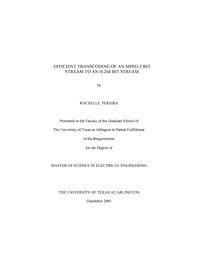
ATTENTION: The works hosted here are being migrated to a new repository that will consolidate resources, improve discoverability, and better show UTA's research impact on the global community. We will update authors as the migration progresses. Please see MavMatrix for more information.
Show simple item record
| dc.contributor.author | Pereira, Rochelle B | en_US |
| dc.date.accessioned | 2007-08-23T01:56:52Z | |
| dc.date.available | 2007-08-23T01:56:52Z | |
| dc.date.issued | 2007-08-23T01:56:52Z | |
| dc.date.submitted | December 2005 | en_US |
| dc.identifier.other | DISS-1135 | en_US |
| dc.identifier.uri | http://hdl.handle.net/10106/500 | |
| dc.description.abstract | Low complexity fast transcoding of an MPEG-2 elementary stream to an H.264 elementary stream.
Objective: MPEG-2 has been a widely accepted video coding standard for various applications ranging from DVD to digital TV broadcast. The new H.264 AVC standard has an even broader perspective to support high and low bit rate multimedia applications on existing and future networks. The advantage in terms of better quality at a lower bit rate is why H.264 is fast replacing MPEG-2. However, the user end hardware had previously been adapted for MPEG-2 streams. This gives rise to a need for portability between MPEG-2 and H.264. The objective of the proposed heterogeneous transcoding process is to achieve standards transcoding from MPEG-2 main profile to H.264 main profile by reusing the data made available in the MPEG-2 bit stream and to perform a comparison with other proposed transcoding architectures.
Algorithm: The proposed research extracts the motion vectors and the transform coefficients from the incoming MPEG-2 bit stream. In the case of I frames, a standard deviation based fast mode decision process is applied to the transform coefficients. The pattern of the standard deviation of the 8x8 blocks within the each macroblock is used to determine the activity of the macroblock and then compute mode decisions compatible with the H.264 specification. In the case of P and B frames, the extracted motion vectors are refined over a one pixel window up to quarter pixel resolution and reused. This allows accommodating quarter pixel motion vectors as compared to half pixel motion vectors from MPEG-2 and it also allows reducing the effect of any errors due to the lossy quantization processes used. Inter frames also use a monotonic mode decision hierarchy, which does not force the MPEG-2 mode decisions yet reduces the computational complexity as compared to the full search motion estimation and mode decision process by 50%. The transcoder proposed reuses information from the MPEG-2 bit stream and also accommodates the advancements of the H.264 standard like sub macroblock partitioned motion search, direct modes in B frames etc. Thus the transcoder achieves low complexity, comparable quality and reduced bit rate in the transcoding process. | en_US |
| dc.description.sponsorship | Rao, Kamisetty R. | en_US |
| dc.language.iso | EN | en_US |
| dc.publisher | Electrical Engineering | en_US |
| dc.title | Efficient Transcoding Of An MPEG-2 Bit Stream To An H.264 Bit Stream | en_US |
| dc.type | M.S.E.E. | en_US |
| dc.contributor.committeeChair | Rao, Kamisetty R. | en_US |
| dc.degree.department | Electrical Engineering | en_US |
| dc.degree.discipline | Electrical Engineering | en_US |
| dc.degree.grantor | University of Texas at Arlington | en_US |
| dc.degree.level | masters | en_US |
| dc.degree.name | M.S.E.E. | en_US |
Files in this item
- Name:
- umi-uta-1135.pdf
- Size:
- 1.221Mb
- Format:
- PDF
This item appears in the following Collection(s)
Show simple item record


